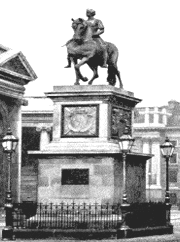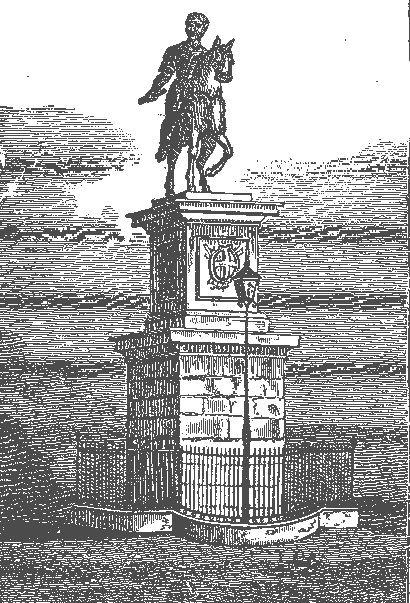 |
King William's Statue, Dublin

|
Those who might think that student pranks are of recent origin should consider the following tale of events in the eighteenth century that followed the erection of an equestrian statue to commemorate the famous William, Prince of Orange. The victory of the Protestant King William of Orange (King ‘Billy’) over the Jacobite army of the Catholic James II at the Battle of the Boyne on 1 July 1690 (old calendar: 12 July in the modern calendar), a battle that ensured the victory of a Protestant succession of the British monarchy, led to that event being commemorated annually by the Orangemen of Ireland. Initially, the Lord Justices of Ireland had authorised a major public celebration on 4 November 1690, King Williams’s fortieth birthday. This took place in College Green in Dublin and consisted of a two-hour long firework display. During the fireworks, a hogshead of claret, given by the Lords Justices to the spectators, was set out in the street so that they could drink to his Majesty’s health. The day ended with the ringing of bells, bonfires in all parts of the city and other demonstrations of ‘public joy and satisfaction’. Most of the nobility and gentry and ladies of quality in and about the city were invited by the Lord Justices to supper, where they had a splendid entertainment and banquet and afterwards ended the night with dancing. However, the bulk of King William’s supporters were not satisfied with such celebrations and wished instead to commemorate William’s military victory over King James at the Boyne on 12 July. This marked a cult of William of Orange, as the Protestant-controlled municipal authorities availed themselves of every opportunity to highlight King William and his achievements. In October 1696 Dublin Corporation had a monument erected at Thosel ‘in praise and honour’ of the King. The following year new mayoral chain for the Lord Mayor of Dublin, the centrepiece of which featured William III, was introduced, while in 1699-1700, Grinling Gibbons was commissioned to cast a statue of the King for a site on the Old Cornmarket. However, the more central location of College Green, across the road from Trinity College, found favour and the statue was unveiled amidst great pomp and ceremony on the eleventh anniversary of the Battle of the Boyne (1 July 1701). It was to serve as a shrine throughout the eighteenth century to the cult of King William. The pattern established was that the Lord Lieutenant of Ireland would lead a parade of nobility and military from Dublin Castle to College Green to salute the statue of William III. On this day the Boyne Society (the Orange Order was not introduced until 1797) marched through the streets of Dublin, sporting colours, banners and arms; and in the evenings there were bonfires, illuminations and ever more elaborate fireworks. The Mayor and Sheriffs of the City of Dublin participated in these celebrations. Not all Irish Protestants were uncritical supporters of King William, and because the King had shown partiality towards Dissenters, Irish Tories were ill at ease with the reverence afforded William III by their Whig rivals. These views were especially entrenched in Trinity College, which overlooked the new statue, and led directly to the expulsion of one student for drinking a toast to Sorrel, the horse that threw William to his death. Another student was stripped of his degree for comparing William unfavourably to an executed highwayman. In 1710, William’s statue was daubed with mud and his sceptre stolen. Following an offer of £100 reward by Dublin Castle and a further £100 by Dublin Corporation, three Trinity students were caught and prosecuted for the offence and sentenced to six months imprisonment, a £100 fine, and to stand a day before the statue they had vandalised with a placard bearing witness to their offence. The sentences were subsequently commuted, but it was too late to save the students university careers and they were not readmitted to the college. However, four years later the sceptre was stolen again and broken, and when those responsible were not discovered, a sentinel was posted to keep guard in a futile effort to save the statue from further vandalism. Over the years the statue continued to attract the unfavourable attention of the students of Trinity College. Towards the end of the eighteenth century, the Dublin Castle administration began moves towards reconciliation with Irish Catholics. As part of this policy, St. Patrick’s Day became the national day of celebration and the 12 July commemoration at King William’s College Green Statue no longer attracted an official presence. The Dublin Orangemen did continue to attend the commemoration throughout the nineteenth century and intermittently up to the outbreak of World War I in 1914. Throughout WW I, and afterwards during the Irish War of Independence between 1919 and 1921, all formal public commemorations ceased and were not resumed after the Anglo Irish Treaty of 1921. In 1929 the Statue was blown up by persons yet to be identified. Ironically, given the animus of the students of Trinity College towards King William’s statue, the site is now occupied by a statue of Thomas Davis, renowned co-founder of the Young Ireland movement, author of the song A Nation Once Again, and graduate of Trinity College. Illustration (below) is a
representation of the equestrian statue of William III., It stands in College-green on a pedestal of granite stone, considerably elevated and surrounded by iron palisades. The pedestal is formed into pannels, and decorated with military emblems. The statue itself is well executed, the king is crowned with a laurel wreath, and on the pedestal is the following inscription; Gulielmo Tertio, Magnae Brittanniae, Franciae, Et Hiberniae Regi, Ob Religionem Conservatum, Restitutas Leges, Libertatam Assestam, Cives Dubliniensis Hanc Statuam Possuere. The statue was erected in 1701, by the citizens of Dublin, to commemorate the Revolution of 1688. It would appear from the very first moment of its erection, this statue has been a source of discontent and ill will. During the government of the Duke of Wharton, an attack was made upon it, which called forth the interference of the Irish government. On the 25th of June 1700, the Jacobites or Tories very much defamed it – twisted the sword from one hand and the truncheon from the other, and daubed the face with some black substance, which could not be removed without scraping. The House of Lords, then assembling in College-green, addressed the Duke of Wharton on the transaction; who, the next day, issued a proclamation, offering a reward of 100 guineas or pounds for a discovery of the guilty persons. The House of Commons was at the time adjourned, but when they assembled, on the 1st of August following, they also addressed his Excellency on the same subject. The authors were never discovered; but the city having caused the statue to be repaired, the thanks of the House of Commons, without a dissentient voice were, were given to the Lord Mayor and citizens for so doing. In more modern times its annual commemoration was a source of much exasperation among the lower orders. This feeling, however, has of late very much
died away.
|

